Digital health is the merging of digital and genomics in healthcare, life, and society. It is about electronically linking the different objects of care so that health instructions and information can be shared.
Digital health enhances and boosts health care outcomes. Caregivers can be provided with sufficient resources and tools to be able to manage care services effectively and efficiently, while people can be monitored in the sympathy and comfort of their own home.
Objectives of digital health
- More capabilities in healthcare delivery
- Enhancing and boosting access
- Lessens the cost
- Expanding and improving the quality of healthcare
- Facilitating the individuals at best
- Personalizing medicine for each patient’s unique requirements and needs
Advantages of digital health
- The patient enjoys digital data access
- In Digital Health, patients get quicker access to test results
- It is easy to pay the bills
- You get the ability to share information with your family members
- It also offers clinicians notes feedback
- The patient can review information for medical errors
- Instructions and Information is simple and easy to document
- The patient has a better approach and access to the medical records
- It saves time
- It can be a tool for health protection
Disadvantages of digital health
- Complicated and complex health information causes concerns for the patients
- Clinician’s reports elevate patient provider’s relationship concerns
- Hackers can approach and access patient’s records
- It needs to be upgraded on a regular basis
- Digital health records are expensive
- Complex and composite processes
Disciplines in digital health
Digital health surrounds many areas and departments that include health portal technology, telehealth, health information technology, and telemedicine. All of these areas are aimed at making the digital health revolution a reality.
Telecare
Telecare is a team that offers Remote care and Remote Patient Monitoring.
Using telecommunication and information technologies, it helps to remove the distance and upgrades, enhances and boosts access to medical technology. It can be used to save the life of people in critical care and emergency situations.
Patient portal technology
Patient Portal Technology in healthcare means convenient online patients’ access to their health information. It is a way through which the patient can interact with the physicians. It optimizes the workflow. It is a user-friendly way of getting into the single point of entry as it helps the patients in what they are looking for.
In-Patient Portal technology, searching is easy, and it develops a better relationship with the doctor and the patient. It also improves your health outcomes.
Mobile phone health
Wireless technology and Mobile phone health are used for the practice of medicine and care delivery. Mobile phone technology is giving awareness to people about healthy living tips and the potential to live better health. With the help of health, there are many applications possible like education, diagnostic support, helplines, remote monitoring, and data collection.
Personalized medicines
Personalized medicine is an emergency practice of medicine. Personalized medicine helps patients to have a more accurate, specific, and powerful approach to healthcare which is customized to individual requirements and needs.
Wearable technology
Wearable technology plays a very important role in medical and healthcare technology.
Wearable technology increases communication and allows multitasking. It also provides convenience as these devices work from everywhere.
Remote patient monitoring
Remote Patient monitoring tools and programs have the potential to coordinate outside the doctor’s office in the patient room. Remote Patient monitoring’s objective is to anchor the patient-generated data from home through a mobile health platform that is connected to the care providers team. It provides better access to practitioners. It also provides personal freedom and independence to the patients.
Remote Patient monitoring also permits and delegates the patients to take a more dedicated approach to their health. RPM helps in earlier diagnosis and is a more convenient way of treatment. It improves and upgrades health without sacrificing the cost and time or convenience.
Remote Patient monitoring has also improved and enhanced the quality of care. RPM has also set up a system through which patients get more engaged with their health. Remote Patient monitoring can upgrade the lifestyle of patients. It also saves money. Remote Patient monitoring provides and bestows the patient with education, support, and feedback.
Telehealth technology
Telehealth technology allows the remote exchange of data between patients and physicians. Telehealth technology helps in diagnosis and monitoring and traditionally used to help patients with long terms conditions.
Teletherapy
Teletherapy has been defined as “the application of technology of telecommunication to the provision of professional services distantly by linking clinician to client, or clinician to clinician for assessment, intervention, and/or consultation.” In short, it is the online therapy.
It is affordable and convenient. It is more comfortable for women as well as children. It also gives the authority to the patients to take control of their own progress. It allows the whole family to be involved.
Benefits
- Teletherapy removes transportation concerns
- A good option for remote areas
- Affordable and convenient
- Teletherapy removes the cost of the gas
- Teletherapy eliminates the hassle
Health information technology
Health information technology is the information technology that is concerned with healthcare settings. It reinforces health information management across computerized systems. It is a secure and fixed exchange of health information between patients and medical experts.
Conclusion
Digital health is an advanced step in the revolution of the practice of medicine. It can surely help in the doctor-patient relationship as it diminishes the distance between the two by always keeping them in touch. It can, in turn, help manage problems in a better way.




Nice write-up.